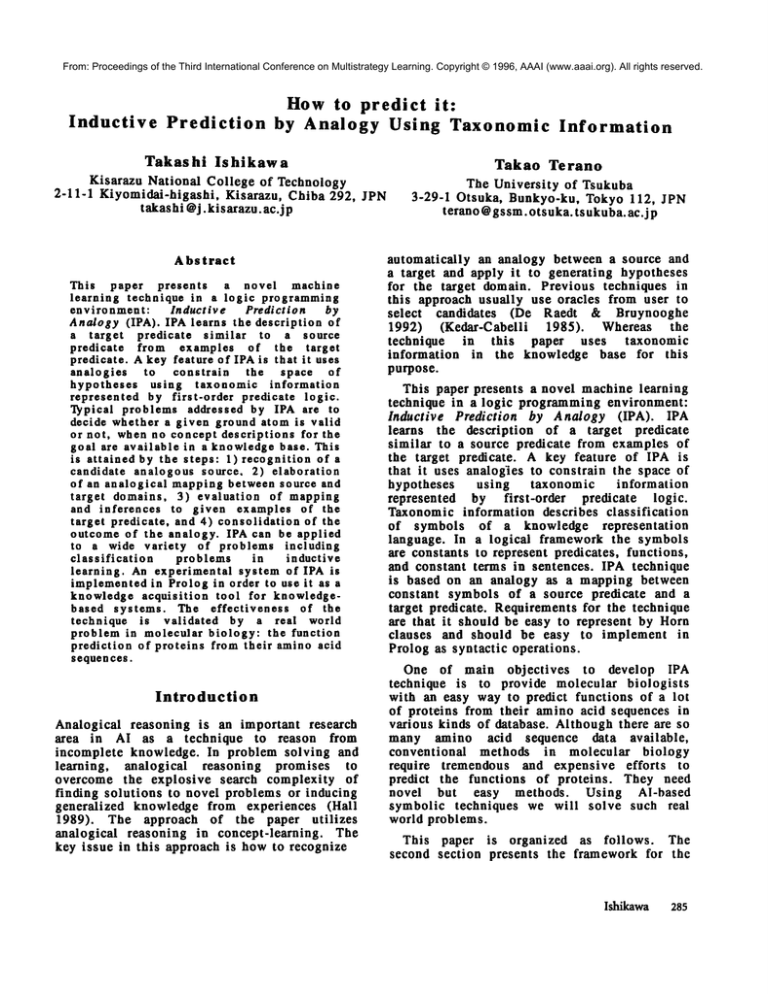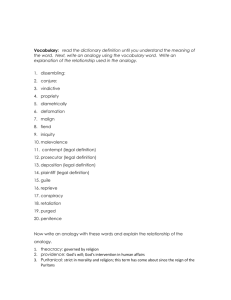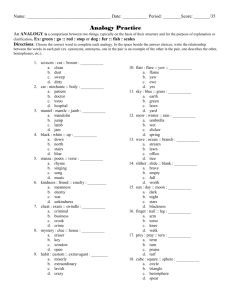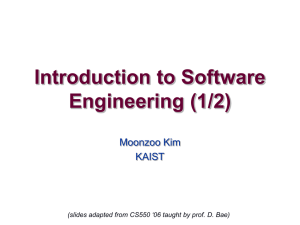
From: Proceedings of the Third International Conference on Multistrategy Learning. Copyright © 1996, AAAI (www.aaai.org). All rights reserved.
Inductive
Prediction
How to predict it:
by Analogy Using Taxonomic
Takas hi lshikawa
Kisarazu National College of Technology
2-11-1 Kiyomidai-higashi, Kisarazu, Chiba 292, JPN
t akash i @j.k i s arazu,ac.j p
Abstract
This paper presents
a novel machine
learning technique in a logic programming
environment:
Inductive
Prediction
by
Analogy (IPA). IPA learns the description
a target predicate similar to a source
predicate
from examples of the target
predicate. Akeyfeature of IPAis that it uses
analogies
to constrain
the space of
hypotheses using taxonomic information
represented by first-order predicate logic.
~pical problems addressed by IPA are to
decide whether a given ground atom is valid
or not, whenno concept descriptions for the
goal are available in a knowledgebase. This
is attained by the steps: l)recognitlon of
candidate analogous source, 2) elaboration
of an analogical mapping between source and
target domains, 3) evaluation of mapping
and inferences to given examples of the
target predicate, and 4) consolidation of the
outcome of the analogy. IPA can be applied
to a wide variety of problems including
classification
problems in
inductive
learning. An experimental system of IPA is
implementedin Prolog in order to use it as a
knowledge acquisition tool for knowledgebased systems. The effectiveness
of the
technique is validated
by a real world
problem in molecular biology: the function
prediction of proteins from their amino acid
sequences.
Introduction
Analogical reasoning is an important research
area in AI as a technique
to reason from
incomplete knowledge. In problem solving and
learning,
analogical
reasoning promises to
overcome the explosive search complexity of
finding solutions to novel problems or inducing
generalized knowledge from experiences (Hall
1989). The approach of the paper utilizes
analogical reasoning in concept-learning.
The
key issue in this approach is how to recognize
Information
Takao Terano
The University of Tsukuba
3-29-10tsuka,
Bunkyo-ku, Tokyo 112, JPN
terano @g ssm. ots uka. ts ukuba,ac.j p
automatically an analogy between a source and
a target and apply it to generating hypotheses
for the target domain. Previous techniques in
this approach usually use oracles from user to
select
candidates
(De Raedt & Bruynooghe
1992) (Kedar-Cabelli
1985). Whereas
technique
in this paper uses taxonomic
information in the knowledge base for this
purpose.
This paper presents a novel machine learning
technique in a logic programming environment:
Inductive Prediction by Analogy (IPA). IPA
learns the description of a target predicate
similar to a source predicate from examples of
the target predicate. A key feature of IPA is
that it uses analogies to constrain the space of
hypotheses
using taxonomic information
represented by first-order
predicate logic.
Taxonomic information describes classification
of symbols of a knowledge representation
language. In a logical framework the symbols
are constants to represent predicates, functions,
and constant terms in sentences. IPA technique
is based on an analogy as a mapping between
constant symbols of a source predicate and a
target predicate. Requirements for the technique
are that it should be easy to represent by Horn
clauses and should be easy to implement in
Prolog as syntactic operations.
One of main objectives
to develop IPA
technique is to provide molecular biologists
with an easy way to predict functions of a lot
of proteins from their amino acid sequences in
various kinds of database. Although there are so
many amino acid sequence data available,
conventional
methods in molecular biology
require tremendous and expensive efforts to
predict the functions of proteins. They need
novel but easy methods.
Using Al-based
symbolic techniques we will solve such real
world problems.
This paper is organized as follows. The
second section presents the framework for the
Ishikawa 285
From: Proceedings of the Third International Conference on Multistrategy Learning. Copyright © 1996, AAAI (www.aaai.org). All rights reserved.
Inductive
Prediction
by Analogy and defines
analogy using taxonomic information.
The third
section describes
IPA technique in detail
and
gives an algorithm
of IPA. In the fourth
section,
we report
an experiment
on IPA
technique in molecular biology applied to the
function prediction
of proteins from amino acid
sequences. In the fifth section we discuss the
strengths
and limitations
of IPA technique and
related
work. Concluding remarks will follow
in the final section.
The
framework
Prediction
for
the Inductive
by Analogy
Inductive
prediction
consists
in finding
an
inductive generalization
of a set of examples of
a concept and in applying it in order to predict
whether a new instance is (or is not) a positive
example of the concept
(Tecuci
1993).
general, the process of inductive prediction
is
to generate concept-descriptions
from examples.
We use a logical framework for concept-learning
(Genesereth
& Niisson
1987) (De Raedt
Bruynooghe
1992).
In IPA technique,
we
assume that the knowledge base is represented
by Horn clauses.
Definition
1. (Concept)
(1) concept is a p re dicate.
(2) concept-description
is a s et of ( def inite)
Horn clauses defining a predicate.
(3) Examples
are ground
instances
of a
predicate.
Positive
examples are true and
negative examples are false.
(4) A concept-description
covers an example, if
the example logically
follows from the conceptdescription
and the knowledge base.
A goal of the inductive prediction
process is
to generate hypotheses from which a target goal
logically
follows
from the clauses
in the
knowledge
base.
The inductive
prediction
process can be used when a query in deductive
inference fails because of the definition
of the
predicate
is not defined in the knowledge base
(Michalski
& Tecuci 1994). We use a target
goal as bias to restrict
the form of hypotheses
(Utgoff
& Mitchell
1982). This type of bias
focuses
the concept-learner
on generating
hypotheses to cover a given target goal.
Definition
2. (Hypothesis)
(1) hypothesis is a c oncept-description of
a
predicate not defined in the knowledge base.
(2) ju stified hy
pothesis covers al l po sitive
examples and no negative examples.
Definition
286
3. (Inductive
MSL-96
prediction)
(1) Inductive prediction is to generate justified
hypotheses covering a target goal.
(2) ta rget go al is a g ro und ins tance of
a
predicate not defined in the knowledge base.
Inductive
Prediction
by
Analogy
Analogy using
taxonomic
information
Analogical
reasoning
is a type of plausible
reasoning based on the following assumption:
Assumption.
If an analogy between a source
and a target
exists,
then properties
of the
source can be projected to the target.
The notion analogy is defined informally
as a
representational
mapping from the source to the
target.
We formalize
analogy using taxonomic
information
in the following
way. We use the
terminology source, target,
mapping, analogy,
and support same as (Hall 1989). First,
formalize taxonomic information as a notion of
sort (Frisch
& Page 1990), then we define
analogy.
Definition
4. (Sort)
(1) so rt r is a s ubset of constant sym bols of
the domain. If constant c belongs to a sort r,
then we describe it as a ground clause r (c)
(2) r’is su bsort of aso rt r i f, and only if,
r(X) can be deduced
from r’(X)
and the
knowledge base.
An analogy
is considered
as a mapping
between elements
of a source domain and a
target
domain.
The analogical
mapping
associates
or maps elements and descriptions
from the source domain into the target domain.
These
mapped elements
are analogical
inferences
and receive
varying
levels
of
supports
from other mapped elements.
This
predicate
mapping restriction
constraints
the
space of possible
clause
mappings.
IPA
technique
employs the observed similarity
by
mapping constants
in concept-descriptions.
Taxonomic information has the role of defining
similarities
among concept-descriptions.
This
mapping
specifies
the analogy
among
predicates.
An analogy
between
literals
is
defined as follows:
Definition
5. (Analogy)
(1) A literal
L1 and a literal
L2 have an
analogy when all corresponding constants in the
literals
belong to each common sort.
The
correspondence
of symbols is decided according
to the syntactical
positions of symbols.
(2) common so rt of twocons tants c I a nd c 2,
is a sort s. if ground clauses s(c 1) *-- and s(c
2)
From: Proceedings of the Third International Conference on Multistrategy Learning. Copyright © 1996, AAAI (www.aaai.org). All rights reserved.
are defined in the knowledge base, or clauses
s(c 1) ,-- and s(c 2) ~ are deduced from the
knowledge base.
(3) An analogy between literals
L1 and L~ is
the correspondence of their constfints [ {eli,
c21)’(c12"n-i c 22), "’"} where c 11, c12 "’" are
constants
the literal L1 and c21, c22,
are
constants in the literal L2".
Example 1 illustrates
an example of an
analogy between the solar system and an atomic
model described in (Gentner 1983).
Example 1. prediction
of an atomic model in
which an electron revolves around a nucleus.
Target descriptions:
~-- revolves_around(electron, nucleus)
attractsfnucleua, electron) *more_massive_than(nucleus, electron)
Source descriptions:
revolves_around(P, S)
celestial_body(P), celestial_body(S),
attracts(S, P),more_massive_than(S,
attracts(sun, planet)
more_massive_than(sun, planet) ~-Taxonomic Information:
physical_object(X) ~ celestial_body(X)
physical_object(X) ~-- elementary_particle(X)
celestial_body(sun)
celestial_body(planet)
elem entary_part icle(electron ) ~-elem entary_particle(nucleus
Analogy:
[ (nucleus, sun), (electron, planet)
(elementary_particle, celestial_body)
Hypothesis:
revolves_around(P, S)
elementary_particle(P),
elem entary_particle(S ),
attracts(S, P),more_massive_than(S,
In this example, the mapping [ (nucleus, sun),
(electron,
planet) , (elementary_particle,
celestial_body)
] is a recognized analogy.
Constant terms sun and planet belong to a sort
celestial_body as well as nucleus and electron
belong to a sort elementary_particle. The sorts
celestial_body
and elementary_.particle
are
subsorts of a sort physical_object.
The target
goal -- revolves_around(electron,
nucleus) is
deduced from the hypothesis generated with this
mapping and by substituting
celestial_body
with elementary_particle in the source conceptdescription.
The algorithm
of IPA
The problem addressed
by the Inductive
Prediction by Analogy is formalized as follows:
Given:
- a target goal, which is a ground instance of
a target concept
- examples of the target concept including
the target goal
- background knowledge
Find: a hypothetical concept-description of the
tarjet concept such that the hypothesis covers
all positive
examples and no negative
examples.
To solve the problem, IPA technique utilizes
the process of analogical reasoning consisting
of four main steps, recognition, elaboration,
evaluation, and consolidation (Hall 1989):
(1) recognition of a candidate analogous source
from a given target goal,
(2) elaboration
of an analogical
mapping
between source and target domains, possibly
including a set of analogical inferences.
(3) evaluation of the mapping and inferences in
some context of use, including justification,
repair, or extension of the mapping,
(4) and consolidation
of the outcome of the
analogy so that its results can be usefully
reinstated in other context.
The steps of the algorithm of IPA technique
is as follows:
Step 1: Recognition.
Find a source ground
clause which is similar to the target goal and
search a source concept-description
which
covers the source ground clause. The recognized
similarity gives a part of an analogy between
the target and the source. If there exist multiple
source ground clauses similar to the target
goal, then IPA selects a candidate in the order
of clause descriptions.
Step 2: Elaboration.
First,
transform the
source concept-description
using the analogy
obtained in Step 1. By replacing each constant
in the source concept-description
with the
corresponding constant in the analogy. Second,
variablize all constants except for the replaced
terms in the body of the transformed conceptdescription,
and instantiate
the variablized
clause with the target goal and the knowledge
base to get detailed analogy between the target
and the source. Finally, transform the source
concept-description using the detailed analogy
to get a target concept-description.
Step 3: Evaluation.
Add the target conceptdescription to the knowledge base and prove the
Ishikawa 287
From: Proceedings of the Third International Conference on Multistrategy Learning. Copyright © 1996, AAAI (www.aaai.org). All rights reserved.
target goal. If the target goal can be proved,
then let the target
concept-description
be a
candidate. If not, retract the candidate from the
knowledge base, then backtrack
to Step 2. If
the candidate covers all the positive
examples
and no negative examples, then let the candidate
be a hypothesis.
If such a candidate cannot be
found, then backtrack to Step 1.
Step 4: Consolidation.
Let the
hypothesis
be a concept-description
target concept.
generated
of the
If the Herbrand base of a target domain is
finite
then the numbers of substitution
for
constant
symbols
is also finite
and an
analogical
mapping is clearly decidable.
This
implies the algorithm of IPA terminates.
An illustration
of the process
of
algorithm of IPA is shown in Example 2.
the
Example 2. Decide whether
a given ground
atom family(mother, mary, kate) is valid or not,
when no concept-descriptions
for the goal are
available in a knowledge base.
Given:
-a target goal ~- family(mother,
mary, kate),
which is a ground instance of a target
concept family(mother,
X, Y)
lucy, sara) "~- an example family(mother,
of the target concept
- background knowledge including
taxonomic
information for constant terms
Find: a hypothetical
concept-description
of the
target concept such that the hypothesis
covers
all
positive
examples
and no negative
examples.
In this example we assume that the following
source concept-descriptions
and background
knowledge are defined in the knowledge base.
Target descriptions:
"-family(mother,
mary, kate)
sex(female,
mary)
parent(mary, kate) .,-sex(female, lucy) ~-parent(lucy, sara)
Example (positive):
mother(lucy, sara) "-Source descriptions:
family(father,
X, Y) ",-sex(male, X),parent(X,
family(father,
john, tom) ~-sex(male, john) ~-parent(john,
tom)~-family(sister,
X, Y)
sex(female,
X),sibling(X,
288
MSL-96
family(sister,
ann, sara)~sex(female, ann)
sibling(ann, sara)
Taxonomic
Information:
faro ily (father) .-family(mother)
faro ily(sister) --sex(male) ~-sex(female)
From the knowledge base above the algorithm
of IPA generates
a hypothesis
family(mother,
X, Y) ",- sex(female,
X),parent(X,
in the
following way:
Step 1: Recognition.
Find a source ground
clause which is similar
to the target goal ~family(mother,
mar),,
kate).
There are two
ground clauses, family(father,
john, tom) ~- and
family(sister,
ann, sara) ".-, similar
to the
target goal, because analogies [(mother, father)]
and [(mother, sister)]
can be recognized using
taxonomic information.
The predicate
family of
arity one defines that the constants father and
mother belong to the common sort family,
and
so on. The algorithm
of IPA selects
family(father,
john, tom) "-- as a candidate for
the source ground clause according to the order
of clause descriptions.
Then search a source
concept-description
family(father,
X, Y)
sex(male,
X),parent(X,
Y), which covers the
source ground clause.
Step 2: Elaboration.
First,
transform
the
source concept-description
using the analogy
obtained in Step 1. By replacing
the constant
father in the source concept-description
with
the corresponding
constant
mother in the
analogy. Second, variablize
the constant male
in the body of the transformed
conceptdescription
except for the replaced terms, and
instantiate
the variablized clause with the target
goal and the knowledge base to get detailed
analogy between the target and the source. Then
the following
target
concept-description
is
generated:
family(mother,
X, Y) ~- sex(female,
X),parent(X, Y
Step 3: Evaluation.
Add the target
conceptdescription
to the knowledge base and prove the
target goal. As the target goal can be proved,
then let the target
concept-description
be a
candidate.
As the candidate
covers all the
positive
examples and no negative
examples,
then let the candidate be a hypothesis. Negative
examples of a concept family(mother,
X, Y) are
all ground instances that satisfy family(father,
X, Y)and family(sister,
X, Y
Step
4:
Consolidation.
Let
the
generated
From: Proceedings of the Third International Conference on Multistrategy Learning. Copyright © 1996, AAAI (www.aaai.org). All rights reserved.
hypothesis
be a concept-description
target concept.
An experiment
in
molecular
of the
biology
In order to demonstrate
the usefulness
of IPA
technique we apply it to the function prediction
of proteins
from amino acid sequences.
An
extremely important
task in molecular biology
is to predict the functions of a protein given its
amino acid sequence
(Shavlik
et al. 1995)
(Hunter 1993) (Schuiz & Schirmer 1979).
problem of this experiment
is to predict
the
functions
of a protein
having an amino acid
sequence similar
to that of bacteriorhodopsin
(Henderson
et al. 1990) in the SWISS-PROT
protein
sequence
database
(Bairoch
Boechmann 1994). Our experiment
shows that
the Inductive
Prediction
by Analogy technique
is useful
at least
for domains with many
structurally related predicates.
prediction by IPA to refine function prediction
of the protein.
Since it is not sure that the
target
protein
has the function
same as the
function
of the protein having the retrieved
amino acid sequences, the function prediction
by IPA refines candidate protein functions to a
specific protein function. The process generates
concept-descriptions
for the candidate functions,
and apply them as classification
rules to
determine a specific
protein function with the
knowledge base. In the process,
the system
learns
new knowledge
and extends
the
knowledge base.
Photon
n
H~
~aminoacid S~luenceJ
~ similar
I
amino
acid
I .......
18
val
I ue.oeratri
[ d ,tafuion.]
,),
[ 4 Ro-Absoption
of proton
+
H
Figure 2. An abstract model of
bacteriorhodopsin
.[ functionprediction
Figure 1. An overview of the system for
function prediction of proteins
System,
The system
for
the function
prediction
of proteins
as shown in Figure 1
inputs an amino acid sequence of a protein with
unknown functions
and outputs
a function
of
the protein.
The system
comprises
two
processes: similar amino acid sequence retrieval
and function
prediction
by IPA. The similar
amino acid sequence retrieval
finds proteins
having similar
amino acid sequences with the
inputted
amino acid sequence from the amino
acid sequence database.
The system outputs a
candidate function of retrieved
proteins
when
their class falls into one function class. If the
function classes are more than one class, then
the system
executes
the next function
Implementation.
We have implemented
a
Prolog
program
based
on the proposed
algorithm of IPA. We have applied the program
to the function prediction
of proteins
having
amino
acid
sequences
similar
to
bacteriorhodopsin
(abbreviated
as bR). bR
one of a few proteins
whose structures
and
functions
are well studied compared to other
proteins.
That is, we know its amino acid
sequence, tertiary
structure,
and biological
functions
(Henderson
et al. 1990). bR is
trans-membrane
protein
and has a function
of
proton pump that transports
proton (H+) across
the membrane of cells.
It is known that the
structure
of bR has seven alpha-helices
and
retinal
as working material
in it as shown in
Figure 2. There are several proteins with amino
acid sequences
similar
to that of bR in the
SWISS-PROT database.
Conventional
method
for the function prediction
of proteins such as
PROSITE (Bairoch
& Boechmann
1994),
however cannot discriminate
these functions.
Also bR is only one protein
whose conceptdescription
for its protein
function
can be
given. In this experiment,
the target protein
Ishikawa
289
From: Proceedings of the Third International Conference on Multistrategy Learning. Copyright © 1996, AAAI (www.aaai.org). All rights reserved.
charge(Res,AC)
with an amino acid sequence similar to bR is
strlng_member(Res,
NSQ° P),
halorhodopsin (abbreviated
as hR)chosen from
in_membrane(P)
,length(NSQ,L),
these proteins, hR transports chloride ion (Ci’)
instead of proton (H÷) in bR as an ion pump.
(member(I,
[1,3,5,7]}
Pos = P ; Pos is L-P+1)
Here we assume that we only know that the
function of hR is one of functions of retrieved
proteins
including
chloride
pump. In the
following,
we will explain the process of IPA
technique for the function prediction of hR. In
the experiment, a hypothesis for the conceptdescription
of chloride pump is generated by
analogical
reasoning
from the conceptdescription of proton pump, and the function of
hR is predicted by justifying the hypothesis.
Problem.
The problem
of the function
prediction
of hR is defined
using Prolog
descriptions as follows:
Given:
- a target goal
function(hR,pump(chloride)
- examples of the target concept including
the target goal
- background knowledge
Find: a hypothetical concept-description
of the
target concept such that the hypothesis covers
all
positive
examples
and no negative
examples.
Knowledge
base.
First
we describe
the
concept-description
of proton pump in the
knowledge base. The description
has the head
literal
function (x, pump (proton))
and
body
literals
including
predicates
ion_acceptor and retinal_binding. The
predicate ion_aceeptor
represents that an
amino acid with opposite charge of transporting
Ion exists
in helix(x)
of the amino acid
sequence
of a protein
x. The predicate
retinal_binding
represents that an amino acid
"K" (retinal binding) exists in helix(I) of
amino acid sequence of a protein x. The terms
helix(1)
.....
helix(7)
represent indices
of
alpha-helices
as a secondary structure
of
proteins. A part of Prolog descriptions
of the
knowledge base for this experiment is shown
below.
%% Prolog
descriptions
of proton
pump
function (X, pump (proton))
ion_acceptoriX,proton,helix(3)
,Posl)
ion_acceptor (X,proton, helix (3) , Pos2)
Posl<Pos2,
retinal_binding (X, helix(7)
ion_acceptor (X, Ion, helix (I) ,Pos)
trans_mem_sequences(X,
SQ)
member (NSQ, SQ° I)
charge(Ion,C)
,opposite(C,AC)
290
MSL-96
retinal_binding(X,helix(I))
trans_mem_sequences(X,SQ)
member(NSQ,SQ,I)
string_member(’K’,NSQ,P)
in_membrane(P)
in_membrane(Pos)
:- Pos>3,Pos<20.
%% positive
examples
function(bR,pump(proton)
function(aR,pump(proton)
function(sR,sensor(light)
%% amino acid sequences
of seven
helices
trans_mem_sequences(bR,
[’WIWLALGTALMGLGTLYFLV"
,
"AITTLVPAIAFTMYLSMLLG’,
"RYADWLFTTPLLLLDLALLV’,
"ILALVGADGIMIGTGLVGAL’,
"FVWWAISTAAMLYILYVLFF’,
"TVVLWSAYPVVWLIGSEGAG’,
"ETLLFMVLDVSAKVGFGLIL’])
trans_mem_sequences(hR,
[’LLSSSLWVNVALAGIAILVFVYMG"
,
"WGATLMIPLVSISSYLGLLSGLTV’,
"SQWGRYLTWALSTPMILLA"
°
"SLFTVIAADIGMCVTGLAAAMTTS’,
"FRWAFYAISCAFFVVVLSALVTDWA’,
"AEIFDTLRVLTVVLWLGYPIVWAV’,
"VTSWAYSVLDVFAKYVFAFILLRW’])
trans_mem_sequences(aR,
[’LWLGIGTLLMLIGTFYFIVKGW’,
"SITILVPGIASAAYLSMFFGIGLTEV’,
"ADWLFTTPLLLLDLALLA’,
"IGTLVGVDALMIVTGLVGAL’,
"WLFSTICMIVVLYFLATSLRA’,
"LTALVLVLWTAYPILWIIGT"
,
"LGIETLLFMVLDVTAKVGFGFILL’])
trans_mem_sequences(sR,
[’TAYLGGAVALIVGVAFVWLLYRS"
°
"SPHQSALAPLAIIPVFAGLSYVGMAY’,
"GLRYIDWLVTTPILVGYVGYAA’,
"IIGVMVADALMIAVGAGAVV"
,
"ALFGVSSIFHLSLFAYLYVIF"
°
"QIGLFNLLKNHIGLLWLAYPLVWLFGP’,
"GVALTYVFLDVLAKVPYVYFFYARRR"
])
%% taxonomic
information
protein(bR)
protein(hR)
protein(aR)
protein(sR)
ion(proton}
ion(chloride)
protein_function(pump(proton)).
alpha-
From: Proceedings of the Third International Conference on Multistrategy Learning. Copyright © 1996, AAAI (www.aaai.org). All rights reserved.
protein_function
(pump(chloride))
can be classified correctly. The refinement is
protein_function ( sensor (light)
executed by backtracking
Step 2 until the
helix(l)
condition is satisfied if needed.
helix(2)
Step 4: Consolidation.
By adding the
helix(3)
obtained concept-description
to the knowledge
hellx(4)
base,
we
succeed
in
deciding
the
function of hR
helix(5)
as
a
chloride
pump
from
its
amino acid
helix(6)
sequence.
helix(7)
Reasoning process.
The algorithm
of IPA
starts
from the following
goal literal
representing that the function of hR is chloride
pump:
Qoal
= function(hR,pump(chloride)
Step I: Recognition.
Find a ground source
clause(analogue)
function (bR, pump (proton))
similar
to the target
goal function (hR,
pump (chloride)
} by making an analogy
between the analogue and the target goal using
taxonomic information defined in the knowledge
base, and search a source clause which covers
the ground source clause.
a,
nalogne
:
function(bR,pump(proton)
)
Result. By applying same procedure above,
IPA technique successfully classifies
protein
functions of all proteins similar to bR, which
are aR (archrhodopsin), sR (sensory-rhodopsin),
and hR (halorhodopsin) (Ishikawa et al. 1995).
Table 1 summarizes the classification
features
of the bacteriorhodopsin-like proteins.
Table 1. Classification features of
bacteriorhodopsin-like proteins
protein
bR, aR
&nalogy
= [ [hR,bR],
[chloride,proton],
[pump(chloride)
,pump(proton)
moQEoe_olaullo
=
function(X,pump(proton)
)
ion_accep~or(X,proton,helix(3),Posl)
,
ion_accepter (X,proton, hellx(3) , Pos2)
Posl<Pos2,
retinal_binding{X,helix(7))
Step 2: Elaboration.
Apply the analogy to
generate a candidate hypothesis for the target
concept-description.
To obtain a valid conceptdescription
of functlon(X,pump(chloride)
),
helix
(3)
in the source clause should be
transformed by variablizing
two constants ’3’
into different variables and instantiating
the
variables
with the knowledge base. The IPA
program generates the following hypothesis for
the concept-description of chloride pump.
TltEget_olltuge
=
function(X,pump(chloride)
)
ion_acceptor(X,chloride,helix(3),
Posl )
ion_accepter (X, chloride, helix ( 6 )
Pos2)
Posl<Pos2,
retinal_binding (X, helix (7))
Step 3: Evaluation.
Next, the generated
hypothesis
for the concept-description
of
chloride pump is refined so that the functions
of proteins having similar amino acid sequences
hR
sR
function
f~.-~
two ,mine acids with
negativechargein helix(3)
one aminoacid with
positivechargein helix(3),
chloride pump
one aminoacid with
positivechargein helix(6)
proton pump
not ion pump no abovefealnres
Instead of using expensive biological efforts,
the system using IPA technique learns these
classification
features
from amino acid
sequences and back-ground knowledge including
taxonomic
information.
Although
the
discovered features for hR and sR have not yet
completely certified
in molecular biology, a
recent research strongly suggests that these
results are probable to be valid (Futai 1991).
This means that the proposed technique is of
use to support novel scientific
discovery from
biological database.
Discussion
and
related
work
The proposed technique IPA is effective
for
generating classification
rules from a very few
number of training
examples.
Instead
of
applying
the proposed
technique
using
analogical reasoning to generate hypotheses of
classification rules, it is difficult to generate
the same classification
rules by the direct
applications of inductive inference techniques
Ishikawa 291
From: Proceedings of the Third International Conference on Multistrategy Learning. Copyright © 1996, AAAI (www.aaai.org). All rights reserved.
to amino acid sequences. Because the proposed
technique
generates
functional
models for
protein
functions
in top down manner,
so
obtained rules have abstract structures
easy to
understand for domain experts.
automatically
can find analogous
even only one example.
The use of analogical
reasoning
prunes
meaningless
generations
of hypotheses
in
generating hypotheses.
Therefore,
the proposed
technique improves the efficiency
of learning.
IPA technique generates a valid hypothesis for a
target literal
simply by variablizing
constant
terms in the explanation
of the target literal
and by instantiating
the explanation
without
searching for generalizations
and specializations
of the terms.
This paper has presented
a novel machine
learning
technique
Inductive
Prediction
by
Analogy (IPA), which learns the descriptions
a target predicate similar to a source predicate
from a few examples of the target
predicate.
IPA technique
allows
the learner
to use
analogical
reasoning in generating
hypotheses
using taxonomic information
represented
by
first-order
predicate logic. The usefulness of the
technique
has been validated
by a real world
problem in molecular
biology:
the function
prediction
of proteins
from their amino acid
sequences.
From the experiment,
we have
observed that the proposed technique generates
interesting
biological
hypotheses from protein
database.
In this paper,
although
we have
focused on molecular
biology,
however, IPA
technique is applicable
in various domains. We
have succeeded
in solving
such problems as
discovery
of the Pythagorean
theorem
and
prediction
of the Rutherford
model of atom
(Ishikawa
& Terano 1994).
Therefore,
believe IPA technique will provide a simple but
strong way in knowledge system development.
IPA technique is applicable
to domains with
structurally
related predicates,
specifically
to
predicates
of same syntactic
structures.
This
limitation
of IPA technique may be overridden
by introducing
the notion of abstraction-based
analogy (Greiner
1988) (lshikawa
& Terano
1993). It is one direction of future research and
we are conducting experiments for the purpose.
The technique
Constructive
Induction
by
Analogy (De Raedt & Bruynooghe 1992) uses
second order schema, which is first introduced
by (Yokomori 1986),
whereas IPA technique
uses taxonomic information
to find analogies.
However,
the algorithm
in (De Raedt
Bruynooghe 1992) requires
asking the clause
question
to the user, whereas IPA technique
automatically
constrains
candidates
using
taxonomic information.
The concept-learning
by analogy in (Tecuci
1993) uses analogy based on determination
rules,
which are introduced
in (Davies
Russell 1987). Determination
rules are higher
order rules and give too strong information
to
transform
source
knowledge
to target
knowledge. In IPA technique,
simple taxonomic
information
plays a role of mapping the source
symbols to the target symbols.
A paper
concerned
with logic
program
synthesis
from examples (Sadohara & Haraguchi
1995) uses abstraction-based
analogy (Greiner
1988) for explanation
structures
of logic
programs.
However,
the algorithm
is
impractical
since the enumeration of analogical
mappings is computationaly
explosive.
Another
paper concerned with analogical
reasoning for
logic programming (Tausend & Bell 1992) uses
mechanisms of Inductive
Logic Programming
(Muggleton
& Buntine
1988).
However the
input of the algorithm
at least requires
two
analogical
examples,
whereas IPA technique
292
MSL-96
examples from
Conclusion
References
Bairoch, A and Boechmann, B. 1994. Nucleic
Acids Res. 22:3578-3580.
Davies,
T. R. and Russell,
S. J. 1987. A
logical
approach to reasoning
by analogy. In
Proceedings
of the International
Joint
Conference
on Artificial
Intelligence
1987,
264-270.
De Raedt,
Interactive
induction
150.
L. and Bruynooghe,
M. 1992.
concept-learning
and constructive
by analogy. Machine Learning 8:107-
Frisch,
A. M. and Page Jr.,
C. D. 1990.
Generalization
with taxonomic information.
In
Proceedings
of AAA1-90, 755-761.
Futai M. eds. 1991. Bio-membrane
(in Japanese). :Maruzen.
Genesereth,
Logical
Intelligence.
Gentner,
theoretical
Engineering
M. and Nilsson,
N. J. 1987.
Foundations
of
A rtificial
:Morgan Kaufmann.
D. 1983.
Structure
mapping:
A
framework for analogy. Cognitive
From: Proceedings of the Third International Conference on Multistrategy Learning. Copyright © 1996, AAAI (www.aaai.org). All rights reserved.
Science 7:155-170.
Greiner, R. 1988. Learning by understanding
analogies. Artificial Intelligence 35:81-125.
Hall, R. P. 1989. Computational approaches to
analogical reasoning: A comparative analysis.
Artificial Intelligence 39:39-120.
Henderson, R. et al.
213:899-929.
1990. J. Mol. Biol.
Hunter, L. ed. 1993. Artificial Intelligence
Molecular Biology.:AAAI Press.
of learning strategy. Machine Learning 11:237261.
Utgoff,
P. E. and Mitchell,
T. M. 1982.
Acquisition of appropriate bias for concept
learning. In Proceedings of Second National
Conference on Artificial Intelligence, 414- 418.
Yokomori, T. 1986. Logic Program Forms. New
Generation Computing 4:305-320.
and
Ishikawa, T. and Terano, T. 1993. Analogy by
Abstraction:
Theory of Case Retrieval
and
Adaptation in Inventive Design Problems. In
Proceedings of AAAI-93 CBR workshop, also
to appear in Expert Systems with Applications
10.
Ishikawa,
T. and Terano,
T. 1994.
A
Formulation of Analogy by Abstraction and Its
Implementation
with Logic Programming (in
Japanese).
In Proceedings
of Knowledge
Reformation Symposium 1994, 156-167.
Ishikawa, T., Mitaku, S., Terano, T., Hirokawa,
T., Suwa, M., and Seah, B-C. 1995. Building a
knowledge-base for protein function prediction
using multistrategy learning. In Proceedings of
Genome Informatics Workshop 1995, 39-48.
Kedar-Cabelli,
S. T. 1985. Purpose Directed
Analogy, In Proceedings
of the Cognitive
Science Society~ Irvine, CA, August 1985.
Michalski, R.S. and Tecuci, G. eds. 1994. In
Machine Learning: A Multistrategy
Approach
Vol. IV .:Morgan Kaufmann. 3-62.
Muggleton, S. and Buntine, W. 1988. Machine
invention of first-order predicates by inverting
resolution. In Fifth International Conference on
Machine Learning:Morgan Kanfmann.
S adohara,
K. and Haraguchi,
M. 1995.
Analogical
logic program synthesis
from
examples. In ECML-95, 232-244.
S chulz,
G. E. and S chirmer,
R. H.
1979. Principles of Protein Structure .: S pringerVerlag.
Shavlik, J., Hunter, L., and Searls, D. eds.
1995. Special
Issues on Applications
in
Molecular Biology, Machine Learning 21.
Tausend, B. and Bell, S. 1992. Analogical
reasoning for logic Programming. In Inductive
Logic Programming.:Academic Press.
Tecuci, G. 1993. Plausible justification
trees:
A framework for deep and dynamic integration
Ishikawa 293





